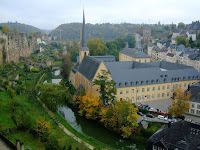 About a day's journey north of London (in a coach and horses) is the small settlement of Stony Stratford, so named because of some stony ground that afforded a crossing over the River Great Ouse valley. The old Roman road, Watling Street, used this crossing but now the A5 which follows the line of Watling Street has been diverted around the town, returning the High St to the locals.
About a day's journey north of London (in a coach and horses) is the small settlement of Stony Stratford, so named because of some stony ground that afforded a crossing over the River Great Ouse valley. The old Roman road, Watling Street, used this crossing but now the A5 which follows the line of Watling Street has been diverted around the town, returning the High St to the locals. Almost adjacent on the High St are two Inns; The Cock and The Bull, and it was at these inns that the travellers would stay at the end of their day's journey from London and regale one another with tales of their journeys, no doubt enhanced after a few jugs of the publicans' finest ale, These fanciful tales were given a name of their own; "a cock and bull story."
Almost adjacent on the High St are two Inns; The Cock and The Bull, and it was at these inns that the travellers would stay at the end of their day's journey from London and regale one another with tales of their journeys, no doubt enhanced after a few jugs of the publicans' finest ale, These fanciful tales were given a name of their own; "a cock and bull story."

After completing the town trail we walked along the bank of the River Great Ouse until it flowed under the iron viaduct on the Grand Union Canal. Leaving the River Great Ouse we took the tow path as far as Cosgrove Lock and then we followed the line of the old Birmingham Canal before branching off back to Stony Stratford.


 Earlier in the day we followed another town trail, this one around Wolveton, or New Wolverton - to be precise. Wolverton was created as a railway town in the 1830s to service the trains on the London-Birmingham line.
Earlier in the day we followed another town trail, this one around Wolveton, or New Wolverton - to be precise. Wolverton was created as a railway town in the 1830s to service the trains on the London-Birmingham line.

































